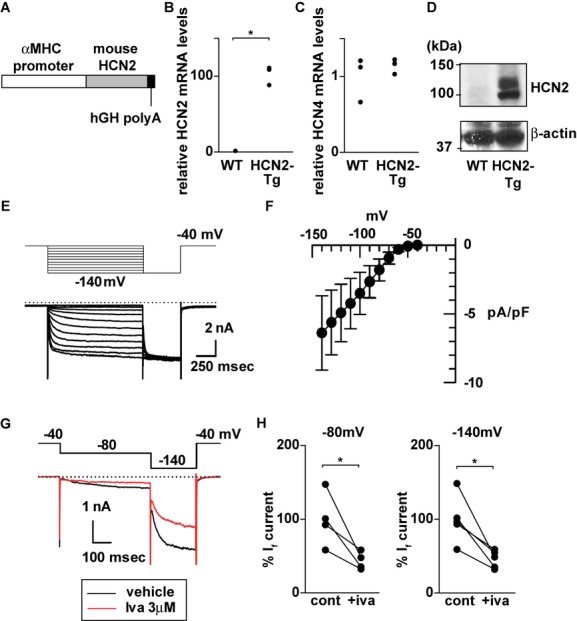Figure 6.

Generation of cardiac‐specific HCN2 transgenic mice. A, Scheme of the construct for HCN2 transgenic mouse. hGH, human growth hormone. B and C, Relative levels of HCN2 (B) and HCN4 (C) mRNA in hearts from 12‐week‐old WT and HCN2‐Tg mice. The Mann–Whitney test was used for the analysis. *P<0.05 vs WT. n=3 in each group. Data are shown as dot plots. D, Representative Western blots for HCN2 and β‐actin in ventricular myocytes from WT and HCN2‐Tg mice. E, Representative If currents recorded in ventricular myocytes from HCN2‐Tg mice. Inward‐rectifier K+ current was suppressed by 0.5 mmol/L BaCl2. F, Current‐voltage relationship for If in ventricular myocytes from HCN2‐Tg mice. The amplitudes of time‐dependent components activated by hyperpolarizing pulses were normalized by cellular capacitance (n=5). G, Effect of 3 μmol/L ivabradine (iva) (red line; 2 minutes after the application of iva) or vehicle (cont) on If in ventricular myocytes from HCN2‐Tg mice. H, Graphs show the suppressive effect of iva on If amplitude at −80 mV (left panel, n=4 each) and −140 mV (right panel, n=5 each) in ventricular myocytes from HCN2‐Tg mice. The mean relative If amplitudes (%) in the absence of iva were assigned a value of 100. The Wilcoxon signed‐rank test was used for the analysis. *P<0.05 vs cont. HCN2‐Tg indicates hyperpolarization‐activated cyclic nucleotide‐gated channel 2 transgenic mice; WT, wild type; cont, control; αMHC, α‐myosin heavy chain.
